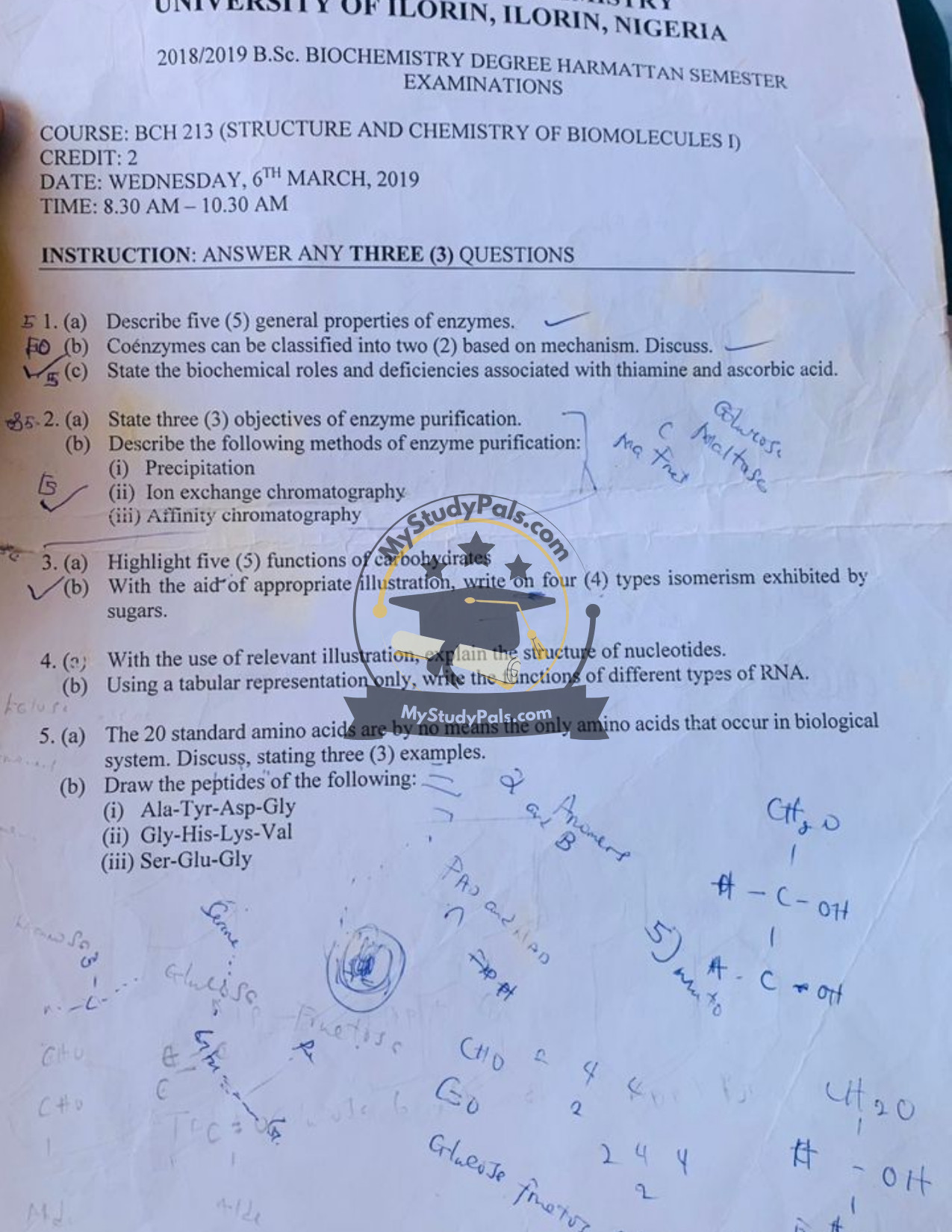ANWSER
Question 1:
(a) Describe five (5) general properties of enzymes.
- Specificity: Enzymes are highly specific to their substrates and reactions.
- Catalytic Efficiency: Enzymes can accelerate reactions by a factor of millions.
- Reusability: Enzymes are not consumed in the reactions they catalyze.
- Sensitivity to Temperature and pH: Enzyme activity can be altered by changes in temperature and pH.
- Saturation: At high substrate concentration, enzyme activity reaches a maximum velocity.
(b) Coenzymes can be classified into two (2) based on mechanism. Discuss.
Coenzymes can be divided into:
- Cosubstrates: These bind temporarily to the enzyme (e.g., NAD⁺, NADP⁺). They participate in the reaction and are released afterward.
- Prosthetic Groups: These bind tightly and permanently to the enzyme (e.g., FAD, biotin), often covalently.
(c) State the biochemical roles and deficiencies associated with thiamine and ascorbic acid.
- Thiamine (Vitamin B1):
- Role: Coenzyme in carbohydrate metabolism (e.g., pyruvate dehydrogenase).
- Deficiency: Causes beriberi and Wernicke-Korsakoff syndrome.
- Ascorbic acid (Vitamin C):
- Role: Antioxidant, collagen synthesis, helps iron absorption.
- Deficiency: Causes scurvy (bleeding gums, poor wound healing).
Question 2:
(a) State three (3) objectives of enzyme purification.
- To study the enzyme’s structure and function in isolation.
- To use in industrial or medical applications.
- To eliminate side reactions in biochemical assays.
(b) Describe the following methods of enzyme purification:
(i) Precipitation:
- Based on solubility. Commonly involves salt (e.g., ammonium sulfate) precipitation to concentrate enzymes.
(ii) Ion Exchange Chromatography:
- Separates enzymes based on charge differences. Enzymes bind to oppositely charged resin and are eluted with salt gradients.
(iii) Affinity Chromatography:
- Based on specific interactions between enzyme and a ligand attached to a matrix. It provides high purity.
Question 3:
(a) Highlight five (5) functions of carbohydrates:
- Primary source of energy (e.g., glucose).
- Storage of energy (e.g., glycogen in animals, starch in plants).
- Structural components (e.g., cellulose in plants, chitin in insects).
- Components of nucleotides (e.g., ribose and deoxyribose).
- Cell signaling and recognition (e.g., glycoproteins, glycolipids).
(b) With the aid of appropriate illustration, write on four (4) types isomerism exhibited by sugars:
- Optical Isomerism: Due to chiral carbon atoms (D- and L-glucose).
- Epimerism: Differ at one carbon atom (e.g., glucose and galactose at C4).
- Anomerism: Differ at the anomeric carbon (α- and β-glucose).
- Structural Isomerism: Different structural formulas (e.g., glucose and fructose).
(Illustrations would include Fischer projections and cyclic structures.)
Question 4:
(a) With the use of relevant illustration, explain the structure of nucleotides:
- A nucleotide consists of three components:
- Nitrogenous base (purine: A, G; or pyrimidine: C, T, U)
- Pentose sugar (ribose in RNA, deoxyribose in DNA)
- Phosphate group
- The base is attached to carbon 1 of the sugar, and the phosphate is attached to carbon 5.
(Illustration: Phosphate—Sugar—Base)
(b) Using a tabular representation only, write the functions of different types of RNA:
| Type of RNA | Function |
|---|---|
| mRNA (messenger) | Carries genetic code from DNA to ribosomes. |
| tRNA (transfer) | Brings amino acids to the ribosome for protein synthesis. |
| rRNA (ribosomal) | Forms the core of the ribosome’s structure and catalyzes protein synthesis. |
| snRNA (small nuclear) | Involved in RNA splicing. |
| miRNA (micro RNA) | Regulates gene expression post-transcriptionally. |
Question 5:
(a) The 20 standard amino acids are by no means the only amino acids that occur in biological systems. Discuss, stating three (3) examples:
- Besides the 20 standard amino acids, non-standard ones exist due to post-translational modification or special functions. Examples include:
- Selenocysteine: Found in some enzymes, similar to cysteine but contains selenium.
- Ornithine: Intermediate in the urea cycle.
- Hydroxyproline: Modified form of proline found in collagen.
(b) Draw the peptides of the following:
(Each peptide should be represented as a sequence of amino acids joined by peptide bonds -CO-NH-)
(i) Ala–Tyr–Asp–Gly
H₂N–Ala–CO–NH–Tyr–CO–NH–Asp–CO–NH–Gly–COOH
(ii) Gly–His–Lys–Val
H₂N–Gly–CO–NH–His–CO–NH–Lys–CO–NH–Val–COOH
(iii) Ser–Glu–Gly
H₂N–Ser–CO–NH–Glu–CO–NH–Gly–COOH


